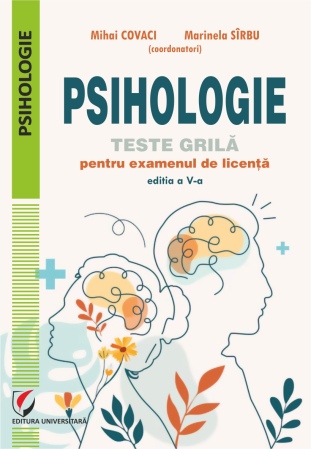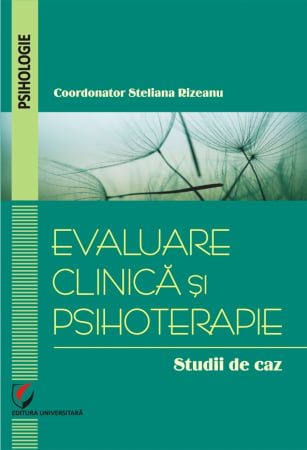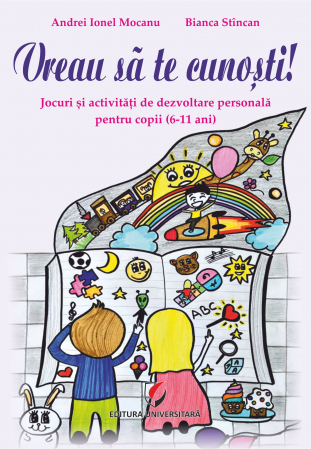ISBN: 978-606-591-270-0
DOI: 10.5682/9786065912700
Publisher year: 2011
Edition: I
Pages: 403
Publisher: Editura Universitară
Author: Irina Holdevici
- Description
- Download (1)
- More details
- Authors
- Reviews (0)
There are people whose behavior is governed by fear and they are aware of it, while others do not have a care that leads to fear life. The latter can travel, have successful professional can speak in public, have proper family life and yet are always overstrung and scared, even though their human fears (fear of spiders, elevator to climb alone or to drive car).
Fensterheim and Jean Baer (1984) believe that any fear is so strong that prevent the person to perform an action is actually a reaction to pathological character.Anxiety is defined as a diffuse fear, without clearly defined objectives, while phobia is defined as a fear of clearly defined objectives (of animals, storm height, etc..).Mentioned authors consider that we can include phobias and fears the more abstract nature, such as fear of responsibility, loss of control, to take part in social events, to be alone or to be rejected.
Behavioral therapists and cognitive-behavioral orientation starting in behavior therapy, the following assumptions:
• Most behaviors are learned anxious type if not all). For this reason, even if you seem to have fear when you know you can unlearn it.
• If an anxious or phobic-like behavior is unlearned (the decondiţionează) no other fears to replace it, but on the contrary, the person get a better adaptation to the environment.
• anxious reaction is a bad habit and like any skill wrong, it can change.
• With special knowledge, of some psychological training based on thinking, imagination and will, anxious type behavior may disappear in a few months (not in a few years).
• You should not even imagine that you release any fear, but you will be able to control your fear, to cope.
Marina is a person who is always scared. He has 25 years, is secretary and spends evenings and weekends all alone. If you receive an invitation to go out, it contains an irrepressible panic (social phobia) because I can think thoughts like: "I will love it friends?," Do not you bored? "Etc..
George is also a person anxious, phobic reactions. Fear of the strongest is fear of failure. Although successfully entered the psychology (17 candidates per seat) he is terribly afraid that it will fall to the license, which has already postponed a third time.Currently he works as a computer operator and suffer so much that there is still a psychologist.
Ruxandra is also fear. Suffering from panic attacks, avoid subway, is afraid to ride in a crowded bus, to go one better market goes up 10 floors on foot than to use the elevator. At first single comes out of the house a little, but now not at all out and had to discontinue college.
Irrational fears and blocks the activity of human life, regardless of age, preventing them to learn, work, travel, in a word, to live normally.
Because anxiety (fear without clearly defined objectives) or type of phobic fears, the person may waive a number of desirable objectives, such as establishing close interpersonal relationships, choice of profession or desired to live a pleasant life, rewarding . In other words, irrational fears can make a person healthy and intelligent person denies.
Those who want to get rid of fear must consider a few things (Fensterheim and Jean Baer, 1984):
- You must know that there are unique circumstances and unrecoverable because there are millions of people suffering from irrational fears and who say that something is wrong with them.
- It is never too late to change. Fensterheim (1984) reports that the oldest patient who successfully treated him for fear of leaving New York was 90 years. After making psychotherapy, he was able to fly by plane to Washington to see his grandchildren.
- Fears and phobias Even old established since childhood, can be treated if the subject of the following steps:
1. The discovery that fear of nature. As noted, some fears are obvious (the plane, the elevator, walking alone on the street, etc..), While others are hidden, such as, for example, fear of rejection (social phobia).
2. Subject should be aware that anxiety and phobias are learned fears, to decipher how they function, which produce physiological reactions as they affect individual lives and what makes "it to keep them." Thus, the subject must realize that huge looming dangers, although they are minor, or even to imagine that there are dangers and fears that extent that it prevents to take things they would like to do.
3. To relieve anxiety and phobias is imperative that subject to follow a program of behavioral and cognitive-behavioral therapy, which consists mainly of desensitization techniques and change the style of thinking. In other words, to do those things he wants to do to not be afraid of them.
4. Programs to combat the fear must be learned and applied together with the therapist in life situations. At the same time subject to change their lifestyle, learning to live with his fears and to completely release them.
An important role of psychotherapy in anxiety states is occupied and updating latent psychic cash through special training, such as, for example, the relaxation or self-hypnosis.
Since ancient times people have suffered from fear. Thus, history and literature gives us many examples. Greek physician Hippocrates still reminded of Damocles, who could not pass over a gap or a bridge. Shakespeare in the play "The Merchant of Venice", talking about fear of cats, and later referred to the living Descartes strange people that can not smell the roses or panicked at the sight of a cat.
Although these symptoms are as old as mankind, only half of the nineteenth century they were considered clinical domain.
Explanatory theories of anxious or phobic behavior type remain the most interesting, in our opinion, psychoanalytic theory, behavioral and cognitivist theory. Thus, Freud believed that phobias is an ego defense mechanism designed to protect human beings against a much deeper unconscious anxieties, anxiety resulting from unresolved Oedipus complex (which refers, essentially, to love and sexual desirechild of the parent of the opposite sex).
He remained famous in the history of psychoanalysis if little Hans, who had phobia of horses (child refuses to walk the streets for fear that it could bite a horse). Freud considered this case and concluded that hiding behind the horse phobia unconscious fear that the child will be punished by the father (by castration) for erotic wish to parent.
During the analytic cure through specific methods, of which the best known are free association and dream analysis, subject to work on it unconsciously reveals the complex and unresolved conflicts. As these complex and likely unconscious conflicts are brought to light, anxieties and phobias disappear, because the subject no longer needs them as a defense mechanism.
The disadvantage of this therapy is that it takes a psychoanalytic very long time (on average 2 years), and the results are uncertain for some categories of subjects. (It is known that patients suitable for psychoanalysis must have a high cultural and intellectual level, a relatively young age - up to 35 years - free time and financial situation enabling them to face the costs of therapy.
If psychoanalysts consider that people are helpless until they manage to unearth all products unconscious conflicts such as in childhood, behavioral psychologists believe that fear is a learned behavior.
Instead of asking, as psychoanalysts, what the person has produced unconscious fear behaviorologists put their questions like the following:
"How has the subject learned to fear?"
"What causes you to unlearn the fear?"
Are well known classics from two experiments which clearly showed that emotional reactions can be learned and unlearned. Thus, in 1920, J.B. Watson, founder of behavioral theory, together with his collaborator Rosalie Rayner, have managed to cause a child of 11 months (Albert) fear of white rats. At first the child was not afraid of rats, but was afraid of loud noises. Based on this observation, researchers have associated the presence of the animal with a loud noise and, after several repetitions, the child developed a fear of animals, even in the absence of noise.Subsequently, the fear has generalized to other situations. Thus, the child became phobic in animals and fur items.
Over several years, Mary Cover Jones has shown that conditioning can be used for the subject to be free of fear. Peter, a child of three years, she was afraid of rabbits.Therapist and the child presented the animal was in the cage, while one gave him candy. The result was that in a few weeks the baby is still playing with house rabbits.
Researchers who have conducted such experiments have been faced with a difficult problem: if fear can be removed, why they still persist in life situations? The answer I gave Hobart Mowrer, who proposed for explaining anxious and phobic behavior theory in two steps or stages:
Step 1: The subject learns to fear through conditioning. Once fear has been fixed, the subject tends to get rid of it.
Step 2: The subject quickly learns how to release fear through two techniques:
a) avoid a situation that triggers fear (fear people will prefer to travel by plane train).
b) Escape from anxiogenă situation when the subject entered into this (the subject gets on the subway, panic and get off at the first station).
Whenever the subject of one of those strategies used to decrease anxiety, but instead reinforce avoidance-escape patterns and this has the consequence that the subject seeks to not expose situations that trigger phobic anxiety-like behavior.
-
Psihoterapia anxietăţii. Abordări cognitiv-comportamentale
Download
Lucrarea „Psihoterapia anxietăţii. Abordări cognitiv‑comportamentale” îşi propune să prezinte cititorului, în detaliu, un număr de tehnici psihoterapeutice, de orientare comportamentală şi cognitiv‑ comportamentală, tehnici care şi‑au dovedit eficienţa în psihoterapie. Acestea sunt menite să contribuie la reducerea anxietăţii şi la optimizarea comportamentului, fiind centrate pe diminuarea unor simptome psihice şi psihosomatice, a consecinţelor nedorite ale anxietăţii şi pe rezolvarea problemelor de viaţă.
Unele din tehnicile prezentate pe parcursul acestei lucrări sunt utilizate în cabinetele de consiliere psihologică şi psihoterapie, iar altele, mai simple, pot fi utilizate chiar de persoanele care suferă de tulburări anxioase nu prea grave, în absenţa unui terapeut calificat.
În prima parte a lucrării sunt prezentate principiile psihoterapiei cognitive şi cognitiv‑ comportamentale, precum şi evoluţia tehnicilor ce se înscriu în acest domeniu. O atenţie specială este acordată metodelor cognitive de evaluare şi autoevaluare a tulburărilor anxioase şi a fricilor umane. În partea a doua a lucrării sunt descrise metode comportamentale şi cognitiv‑comportamentale de terapie a tulburărilor caracterizate prin anxietate generalizată şi atacuri de panică, precum şi a tulburărilor fobice şi obsesiv‑compulsive. Sunt analizate în detaliu şi aspectele psihologice ale fobiei sociale.
O parte însemnată a lucrării este dedicată anxietăţii legate de problemele sexuale şi de relaţiile interpersonale.
Particularităţile şi caracteristicile societăţii în care trăim, nesiguranţa resimţită permanent determină ca din ce în ce mai mulţi indivizi să se confrunte cu acest fenomen: anxietatea. Prezenta lucrare se înscrie în acest context. Ea îşi propune să ofere un motiv de reflecţie în legătură cu demersul psihoterapiei moderne şi facilitează înţelegerea apariţiei tulburărilor care au la bază anxietatea.
Autoarea, prof. univ. dr. Irina Holdevici, cu peste 25 de ani de experienţă ca psihoterapeut şi psiholog specializat în optimizarea performanţelor umane, recunoscută în ţară şi străinătate, a publicat numeroase volume, studii şi articole în domeniul psihoterapiei cognitiv‑comportamentale.
Volumul de faţă se remarcă prin ansamblul de cunoştinţe ştiinţifice transmis, invitând cititorul să se întrebe în legătură cu modul în care tehnicile de psihoterapie rezolvă numeroase probleme de viaţă cu care se confruntă oamenii sau în legătură cu dificultăţile pe care le întâmpină şi de care trebuie să ţină seama terapia.
Această reflecţie se sprijină, în mod obligatoriu, pe o informare bogată referitoare la cercetările din domeniul psihoterapiei anxietăţii. In această privinţă, lucrarea este cuprinzătoare, exemplele sunt foarte clare, fiind analizate sistematic şi articulate cu grijă din perspectiva adoptată în lucrare. Mai mult decât atât, unele tehnici prezentate pot fi utilizate de către persoanele cu probleme uşoare care doresc să se autoperfecţioneze, să devină mai sănătoase şi mai eficiente, prin aceasta tehnicile respective dobândind caracterul unor metode de autoreglare a comportamentului.
Lucrarea se prezintă ca o lectură agreabilă, care îmbină rigoarea şi stilul academic cu aplicaţiile practice şi studiile de caz, tratate personal de autoare sau preluate din literatura de specialitate din ţară şi străinătate.
Cartea se adresează deopotrivă medicilor şi psihologilor interesaţi de problemele psihoterapiei, studenţilor la medicină şi psihologie, dar şi publicului larg, tuturor celor ce doresc să se iniţieze în domeniul psihoterapiei comportamentale şi cognitive, preocupaţi de cunoaşterea şi aplicarea unor metode de reglare şi autoreglare psihică, de problematica tulburărilor anxioase şi însuşirea tehnicilor de contracarare a acesteia.
Prof. univ. dr. Mihai Golu
He has published 25 books and over 100 studies and articles in clinical psychology, psychotherapy and psychology of sport.
Clinical hypnosis is a psychotherapist and trainer in cognitive-behavioral psychotherapy.

6359.png)
![Psychotherapy anxiety. Cognitive-behavioral approaches [1] Psychotherapy anxiety. Cognitive-behavioral approaches [1]](https://gomagcdn.ro/domains/editurauniversitara.ro/files/product/large/psihoterapia-anxietii-abordri-cognitiv-comportamentale-1799-560176.jpg)














